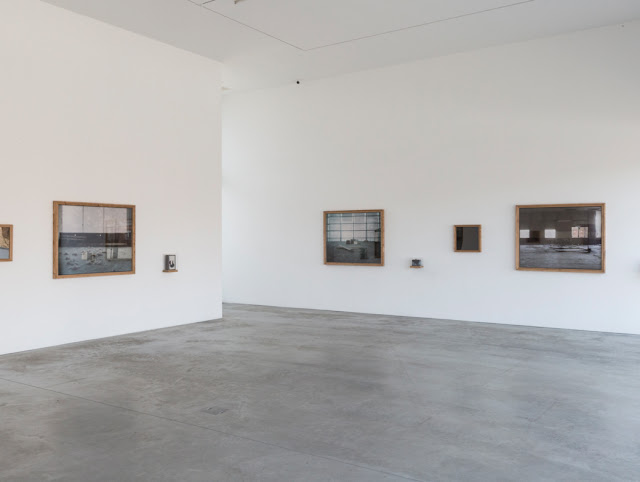Helen Marten “Eucalyptus, Let us in”
You + Us
When archaeologists dig with hopes of unearthing nameable fragments, they seek to return latent abstractions to figuration.
Bones, buildings, cups and spoons are entered into a new jig of re-articulation. Gathered and spat back out as collaged chronologies, the collected warmth of real-life perforations sieve these findings out of buried flatness and back into daily language. Once concealed by mud and foliage, sought-out areas become marked sites, places with contemporary traction.
The erased strokes of ancient activity are put back to work: vector grids symbolically allocate meaning or position to animals and humans alike. The enigma of labour necessitated by gravity–the haptic investments in making buildings stand upwards–is provided with a solid topological outline. Handwriting, numbers and vocabulary enter into new formal logic. The discovery might be intense or fragile and it is almost certainly ringed with a hallucinatory outline, which is at once a tracing of signs and alchemical process.
The drawing of a floor plan can also be read as the abstraction of an idea. Fantasy and philology allow mutation: sociological procedure, technological metaphor, erotic image, or surreal apparition bond as a muttering mass.
This might be something to do with making images that have an imposed itinerary quality, but are also disassembled to the point where they can be allowed to be non-committal if required. Flatness allows a literal description of movement, of A to B navigations, with the vector line being a suitably fast mechanism of delivery. But the point at which things become husked down to geometric memories of themselves is also the point when definition gets flabby: this tree is a drunken tree; that house has a pain in its side. Even the dismal colloquialisms of workplace melodrama can be exported, metaphors in essence: think of a spoon, jugs, stones, all invested with personality enough to converse with human crassness.
So of course it is a common idea that if we witness a foreign entity, we perceive it for the pure abstraction of its difference. A visible suspension of particles in the air – the smoggy, wispy blotch of smoke or burning – provides alien stimulation. There is something exotic in the fear and energy possessed by substance so closely linked with an extinguishing of inhalation. The puff-of-smoke is smoke-as-object, a clearly defined spectacle of the miracle of the atomic. So what is the essential nature of smoke? Obfuscator? Comic enabler? Sympathist?
When we apologize, the depth of sincerity can be deliberately fuzzy. A drip–of paint, of piss, of ice–is treacherous, but really sorry too. It is pure tragicomedy. In painterly form, the “apology” is a grim reflection of the human body, a caricature: beaded broken lines, little blobs and libidinous squiggles retain an elastic firmness. They are materially treacherous, with the paint itself playing plasticity made fixed substance; it is immutable and precisely without the warmth of flesh. But it is an extension of intension and we can apologize preemptively on its behalf. This is validation: Apologies! There is calculation and further archaeological gathering. Colour participates as though queered or gendered; the simple action of doubling forces tautological shortcut and collapse of definition; dysfunctional eyes are clouded by an auditory film and ears by a diagrammatic mapping of sensory importance. The mouth, the hand, the tongue are all involved. Our vast gray milkshake of information flexes and bends at will, a planktonic swarm of signs where merchandise, language, and spirituality all participate proudly in the stew of reality.
There are 8 new works in the exhibition.
Eucalyptus is one of three similar genera; many species, but far from all, are known as gum trees because they exude copius “gum” (bloodwood/red gum/kino) from any break in the bark. The generic name is derived from the Greek words “well” and “to cover”, referring to the cap on the stem which usually conceals the flower before it blooms.
Helen Marten
until 25 February 2016




Helen Marten installation views at Greene Naftali, New York, 2016
Courtesy: the artists and Greene Naftali, New York.
Tony Conrad “Undone”


Framing Forms
In storytelling it may be possible to separate the language of the story from the contextualizing “framing” words that say what an author is about to do. This is the story of my “Yellow Movies”. The framing language is an axe blade, a precipice or cusp dividing the voice of the account into the teller and the told. In the “Yellow Movies,” a black edge serves this framing function. What stands within the demarcation formed by the sharp inner framing edge of the screen rectangle is part of the story; everything else is there to play a “helping” role.
Whatever “help” the author may provide, the space inside a screen frame belongs to the viewer. But a screen space is temporally loosened from the viewer’s moment; it is the potent(ial) field for images of the past, of the present, of the future: that is to say, the screen space is the topos of the image/ination.
Just as some other kinds of art are fulfilled only through the co-presence of the viewer—through the visitor’s psychic projection into a social space they share with the work—film frames are doubly-incomplete spaces: incomplete on the one hand in the haptic imagery offered by the work, and on the other hand in the psychic projection which the visitor may wrest from this encounter.
Tony Conrad
until 27 February 2016




Tony Conrad installation views at Greene Naftali, New York, 2016
Courtesy: the artists and Greene Naftali, New York.
http://moussemagazine.it/helen-marte-tony-conrad-greene-naftali-2016/






















